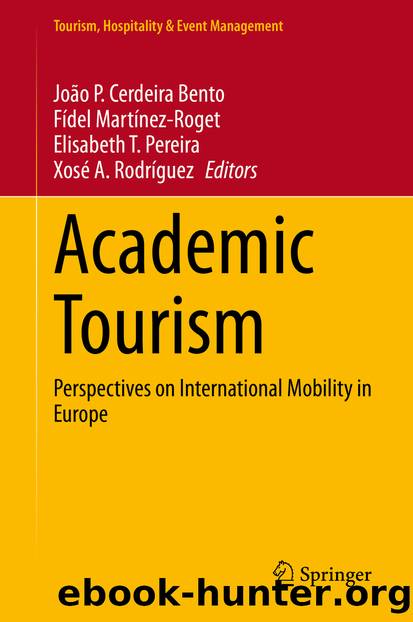Academic Tourism by Unknown

Author:Unknown
Language: eng
Format: epub
ISBN: 9783030572884
Publisher: Springer International Publishing
6.5 Language Tourism in Spanish Higher Education Contexts
According to Project Atlas (Institute for International Education n.d.), in 2018 Spanish universities welcomed 109,522 international students, mainly from Italy, France, the US, Germany, and Mexico. Piédrola et al. (2016) state that nowadays universities and the agreements they reach play a fundamental role in the language tourism landscape, and it has been empirically verified that language tourism has obtained more support in those cities where universities and public administrations have cooperated with each other.
Aliaga et al. (2018) distinguish four different types of language tourism providers: third-party providers, higher education institutions, language tourism agencies, and language schools, whose main business priority is language courses. A third-party provider is an independent organisation that facilitates study abroad programmes acting as an intermediary between universities. It is mostly hired by American and Canadian universities or independent students that want to go abroad with an all-inclusive package, which often includes accommodation, course registration at the Spanish university, medical insurance, transfers, cultural visits and trips, as well as other activities like volunteering or leisure pursuits, sometimes with local residents. Their educational programmes combine Spanish courses with other academic content to gain credits and transfer them to their home universities. Conversely, higher education institutions do not offer a complete package, only tuition and accommodation at university campuses for an extra cost. Students are more independent and usually have to organise their own trip.
Language tourism in higher education environments located in different Spanish regions has been researched by several authors. Given that language tourists tend to stay longer in their destinations than mass tourists, their direct, indirect and induced positive economic impacts are significant (Piédrola et al. 2017), for example in Castilla-La Mancha (Aranda and Molina 2007), Salamanca (Carrera et al. 2009; Pardo 2011), Valladolid (Redondo-Carretero et al. 2017), Galicia (Taboada de Zúñiga 2010; RodrÃguez et al. 2012, 2013), Alicante (Barra et al. 2019), Barcelona (Iglesias 2017b) and Córdoba (Piédrola et al. 2016).
Pardo (2011) maintains that the effects of language tourism are globally positive for Spain, and more specifically for those cities whose cultural heritage and prestigious universities are well-known. He pinpoints several benefits for two such cities, namely Salamanca and Alcalá de Henares. From a socioeconomic perspective, longer stays are favoured instead of one-day excursions from nearby Madrid, so new service providers and employment opportunities arise, and leisure activity is boosted. Furthermore, the economic growth leads to urban regeneration and architectonic restoration in the long run. The image of these cultural cities and their centenary identity are strengthened, and their international projection is reinforced. Consequently, language tourism allows for greater diversification, reduces seasonality, fosters the use of cultural services, enhances the image of these destinations, and increases economic profitability, which stimulates the demand for complementary activities intertwined with other types of tourism, e.g. gastronomic, rural, backpacking or sports. As indicated by Carrera et al. (2009), 67% of the Erasmus students who studied at the University of Salamanca in 2006 took complementary Spanish courses. The numerous Erasmus students who stay in
Download
This site does not store any files on its server. We only index and link to content provided by other sites. Please contact the content providers to delete copyright contents if any and email us, we'll remove relevant links or contents immediately.
Life 3.0: Being Human in the Age of Artificial Intelligence by Tegmark Max(5473)
The Sports Rules Book by Human Kinetics(4288)
The Age of Surveillance Capitalism by Shoshana Zuboff(4207)
ACT Math For Dummies by Zegarelli Mark(3982)
Unlabel: Selling You Without Selling Out by Marc Ecko(3587)
Blood, Sweat, and Pixels by Jason Schreier(3564)
Hidden Persuasion: 33 psychological influence techniques in advertising by Marc Andrews & Matthijs van Leeuwen & Rick van Baaren(3472)
The Pixar Touch by David A. Price(3362)
Bad Pharma by Ben Goldacre(3351)
Urban Outlaw by Magnus Walker(3338)
Project Animal Farm: An Accidental Journey into the Secret World of Farming and the Truth About Our Food by Sonia Faruqi(3174)
Kitchen confidential by Anthony Bourdain(3006)
Brotopia by Emily Chang(3000)
Slugfest by Reed Tucker(2937)
The Content Trap by Bharat Anand(2860)
The Airbnb Story by Leigh Gallagher(2797)
Coffee for One by KJ Fallon(2559)
Smuggler's Cove: Exotic Cocktails, Rum, and the Cult of Tiki by Martin Cate & Rebecca Cate(2469)
Beer is proof God loves us by Charles W. Bamforth(2369)
